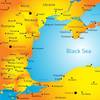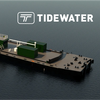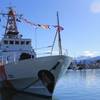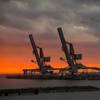Although a small nation on the Atlantic shores, Portugal in the 16th century was credited with discovering most of the “New World” previously unknown to Europe. In the process it became the richest nation in the West. The names of Bartolomeu Dias (Africa), Vasco da Gama (India) and Fernão de Magalhães – Magellan, who led the first circumnavigation of the globe but was killed in the attempt – echo down the centuries.
Over the years the country underwent a transformation and saw the hard won glory fade. In fact until 1974, strong public protection dominated the national shipping sector, especially regarding merchant shipping to Portugal’s overseas territories. In that period, shipping policy was regarded as an instrument of integration for the colonies and therefore the Portuguese fleet received large subsidies. In the second phase, when Portugal lost most of its overseas territories, as a consequence it also lost most of the merchant shipping trade with those territories. This had a direct negative impact on merchant shipping.
Today, the country is caught up in the turmoil of an apparently interminable Eurozone crisis. The government is taking initiatives to revive the country’s marine industries – or create new ones in a bid to recover its lost glory. Already, in the port sector things are looking up. The reform and modernization schemes of the recent past have had a positive impact on Portugal’s ports. The combined cargo handled at the country’s ports has shot up to 83 million tons in 2014, from just 61 million tons that was handled in 2009. More is expected. Both Leixões (Porto), Lisbon and Sines are in the process of expanding their existing container terminals and overall port capacity. In these ports new greenfield terminals are also being developed.
New cruise terminals have also been developed for Leixões (Porto), Lisbon (Santo Apolônia), the Algarve (Portimão), the Azores (Ponta Delgada) and Madeira (Funchal). The country is also investing in a string of new marinas.
Shipping Registry
Portugal has two Ship registers for vessels entitled to fly the Portuguese flag and under the same Maritime Administration viz. the Conventional register and the International register. The Conventional one is the “traditional” Portuguese register of ships. It is carried out by maritime authorities’ offices (Capitanias or Delegações Marítimas) existing in each port in Portugal. Ships and owners in this register comply with all the Portuguese applicable legislations. The other known as the International Shipping Registry of Madeira (MAR) was created to reduce the country’s “flagging out” process as well as to attract new ship owners and vessels. The advantage being that this register offers a favorable tax regime, applicable to both vessels and shipping companies licensed within the legal framework of the International Business Centre of Madeira. Ships are registered by the MAR Technical Commission (CT-MAR), with an office at Funchal, Madeira Island, and their home port is “Madeira”. However, from the technical point of view ships registered at MAR are subject to the same maritime legislation as the ships of the conventional register. Last year by the end of September MAR became the fourth largest international shipping register of the European Union, reaching the largest number of vessels since its creation, with a total of 316 vessels registered in MAR, 53 more than the total number registered at the end of 2013. A significant achievement was the decrease of the average age of the commercial vessels registered in MAR from 15.5 years at the end of 2013 to 12.5 years in late September.
Ship Building
Despite the growth in shipping tonnage, the shipbuilding industry is limited in size. The world share of the Portuguese shipbuilding industry was only 0.002% in 2012 in terms of completion (measured in GT). Portugal has around five major shipyards and around 200 ship repair companies, some of which are very small facilities, with minimal activity. The biggest shipbuilder engaged in newbuilding is Estaleiros Navais de Viana do Castelo, S.A. (ENVC), which is currently owned by Empresa Portuguesa de Defesa SGPS S.A. (EMPORDEF), a public holding, held 100% by the Portuguese government. The other companies also construct small ships (below 100 GT) such as passenger ships and fishing vessels, and some also work in the sector of manufacturing offshore equipment. Lisnave is dedicated exclusively to ship maintenance. The situation has been weakened by an inadequate research and development (R&D) base. Employment in the shipbuilding and maintenance / repair industry as a whole has been decreasing. Where the number of workers involved was around 10,000 in the late 1990s, this number has fallen to about 6,000 in 2006 which number further dropped to about 3,800 in 2013. Since 2010, only one or two vessels have been constructed per year and published statistics suggest that no new orders for vessels over 100 GT have been received since at least 2009 (although the Portuguese government highlighted that orders were received in 2009, 2010 and 2011 by two shipyards, for asphalt carriers, ferries and hotel river ships). The Portuguese government offers no specific direct or indirect support measures to the shipbuilding and maintenance / repair industry, although firms have access to general programs of export credit guarantees and insurance, plus loans and loan guarantees to small and medium-sized enterprises.
Classification Society
Portugal has a classification society, Registro Internacional Naval, SA (RINAVE), established in 1973. RINAVE is authorized to conduct surveys and issue certificates in order to verify a vessel’s compliance with relevant international conventions, codes, etc. Portugal is also home to the European Maritime Safety Agency (EMSA), which provides technical assistance and support to the European Commission and member states in developing and implementing European Union legislation on maritime safety, ship pollution and maritime security.
Portugal consumes about 600,000 tons of fish a year, twice as much as it produces, and is the world’s third highest fish consumer per capita after Iceland and Japan. Yet the fisheries industry is hardly growing with only 74 vessels of up to 80 meters in length.
Oil & gas
Though relatively modest offshore exploration is taking place, Portugal has good potential to become an oil & gas storage, shipping and services platform. The country is well situated between several markets in Europe, Africa and the Americas.
There are also excellent bunkering facilities. One major strength Portugal banks on is the coastal tourism sector which has a good infrastructure base, including a large number of hotels and restaurants. Portugal is also widely known as a ‘sun and beach’ destination. The highest concentration of tourism comes in the period from May to October and in specific regions such as the Algarve, Setúbal, Lisbon, Peniche (Berlenga), the Azores and Madeira. The reason behind the gradual development of the tourism sector in Portugal is mainly: the increasing number of European citizens travelling abroad for their holidays; the length of the country’s coastline; and the good weather conditions of the country.
Portugal Facts
Following its heyday as a global maritime power during the 15th and 16th centuries, Portugal lost much of its wealth and status with the destruction of Lisbon in a 1755 earthquake, occupation during the Napoleonic Wars, and the independence of Brazil, its wealthiest colony, in 1822. A 1910 revolution deposed the monarchy; for most of the next six decades, repressive governments ran the country. In 1974, a left-wing military coup installed broad democratic reforms. The following year, Portugal granted independence to all of its African colonies. Portugal is a founding member of NATO and entered the EC (now the EU) in 1986.
Population: 10,825,309
(July 2015 est./80th in the World)
Area:
Total: 92,090 sq km
Land: 91,470 sq km
Water: 620 sq km
Note: includes Azores and
Madeira Islands
Coastline: 1,793 km
Waterways: 210 km (on Douro River from Porto)
Maritime Claims
territorial sea: 12 nm
contiguous zone: 24 nm
exclusive economic zone: 200 nm
continental shelf: 200-m depth or to the depth of exploitation
Merchant Marine
Total: 109
By type: bulk carrier 8, cargo 35, carrier 1, chemical tanker 21, container 7, liquefied gas 6, passenger 13, passenger/cargo 5, petroleum tanker 3, roll on/roll off 1, vehicle carrier 9
Foreign-owned: 81 (Belgium 8, Colombia 1, Denmark 4, Germany 14, Greece 2, Italy 12, Japan 9, Mexico 1, Norway 2, Spain 18, Sweden 3, Switzerland 3, US 4)
Registered in other countries: 15 (Cyprus 2, Malta 3, Panama 10)
Ports & Terminals
Major seaport(s): Leixoes, Lisbon, Setubal, Sines
LNG terminal (import): Sines
Source: The World Factbook
2013-14. Washington, DC:
Central Intelligence Agency, 2013
(As published in the September 2015 edition of Maritime Reporter & Engineering News - http://magazines.marinelink.com/Magazines/MaritimeReporter)













